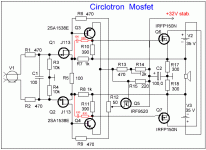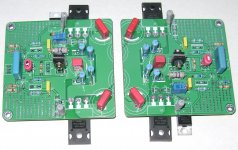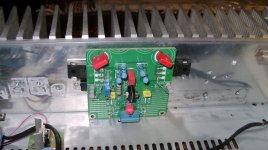what brand ?
they are more expensive and less transconductance than 150N from infineon
but they are usable but in simulation they were less efficient
Nelson Pass :
Power Mosfet Choices
they are more expensive and less transconductance than 150N from infineon
but they are usable but in simulation they were less efficient
Nelson Pass :
Power Mosfet Choices
Last edited:
7€ pièce 😱😕
190€ / 30p
given the price it would be necessary that it is sorted of origin, impossible to order 50
Last edited:
actually the 33p is not mandatory (I did not have it on mine and it did not oscillate)
BUT in simulation on capacitive load of 1uf the amp oscillated without the 150p
BUT in simulation on capacitive load of 1uf the amp oscillated without the 150p
actually the 33p is not mandatory (I did not have it on mine and it did not oscillate)
BUT in simulation on capacitive load of 1uf the amp oscillated without the 150p
But in my version there are j113, BC557B, IRF1010E. Maybe that's why?
What do you think about removing the 100uf cap ?
On listening I think it's better, and in simulation it greatly improves PSSR
On listening I think it's better, and in simulation it greatly improves PSSR
What do you think about removing the 100uf cap ?
On listening I think it's better, and in simulation it greatly improves PSSR
I did not try to remove the 100.0 uF capacitor. I want to put 2 uF of Wima instead.
currently I've removed but yes you're right a little mkp would be the solution
Joe what do you think about this ?
Joe what do you think about this ?
Joe what do you think about this?
Very interesting result, thanks for sharing. This is just the kind of detail you can only sort out by building and listening, I think.
In theory, the cap is there to keep common mode supply noise out of the front end. However, I've seen in simulations that removing the cap actually reduces even-order harmonic distortion. That could be what you're hearing, or it could be that removing the cap cleaned up the sound by removing supply noise that the cap was coupling into signal ground.
Either way, I'm OK with removing the cap if it improves the sound, as long as it doesn't result in common mode oscillation. You can check for that by watching either output terminal to ground. If you see oscillation, you could try jpatay's suggestion of using a smaller cap value in place of the 100 uF.
It won't work as shown because the current from +32V returning to ground through R17-R18 puts a positive DC voltage on the output rails, which turns off J1-J2. You may be better off with a completely separate front-end supply, which is really a different design approach.
Yes, there will be a separate transformer and a separate stabilized power supply.
I will try this later, but for now I will just repeat the design of the amplifier.
I will try this later, but for now I will just repeat the design of the amplifier.
Last edited:
- Home
- Amplifiers
- Solid State
- Current feedback Mosfet Circlotron





